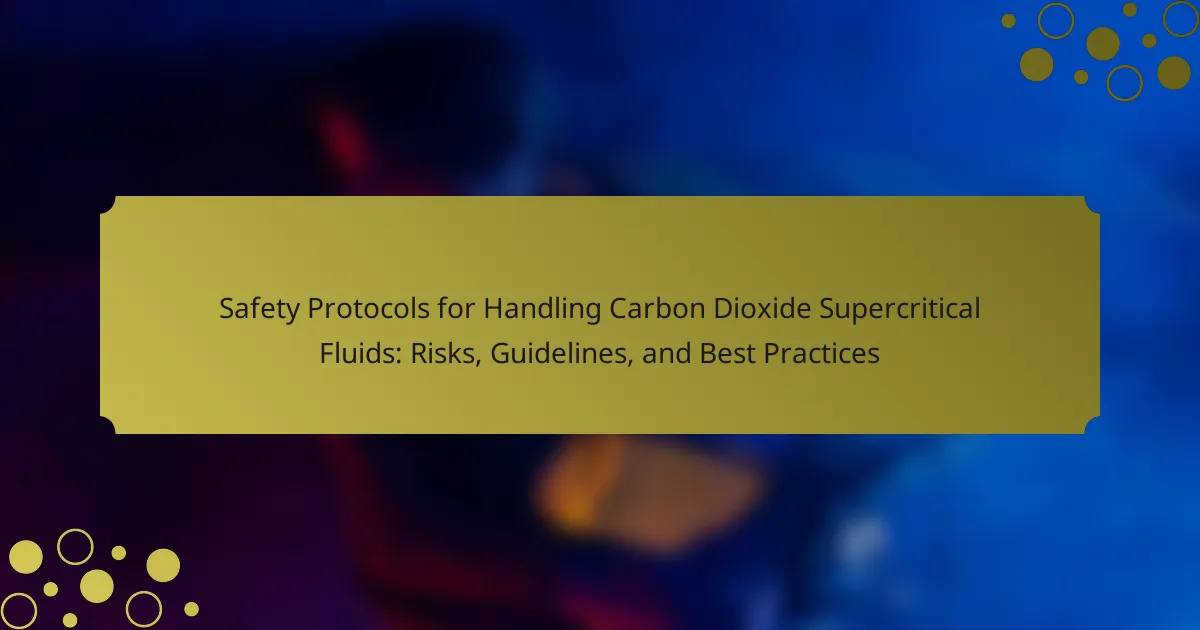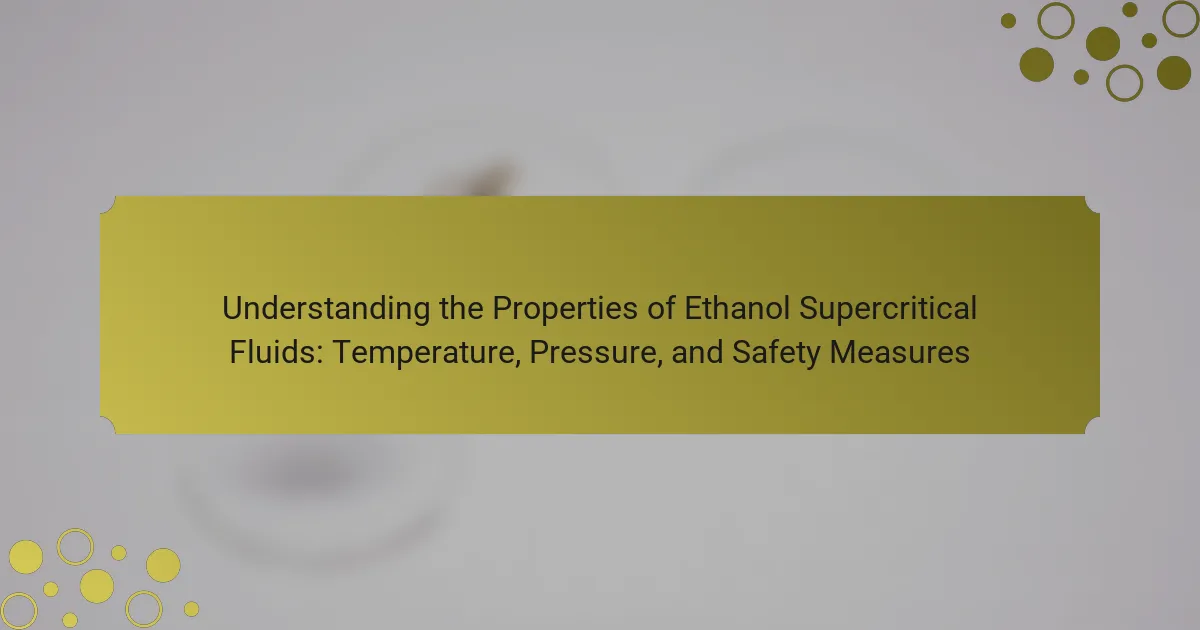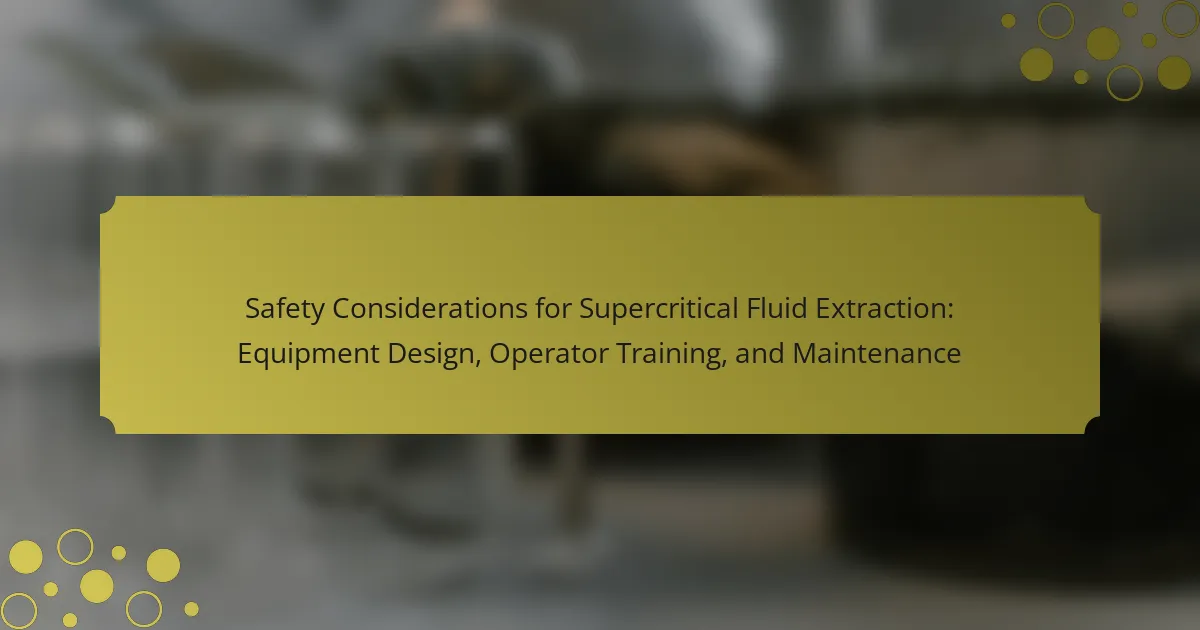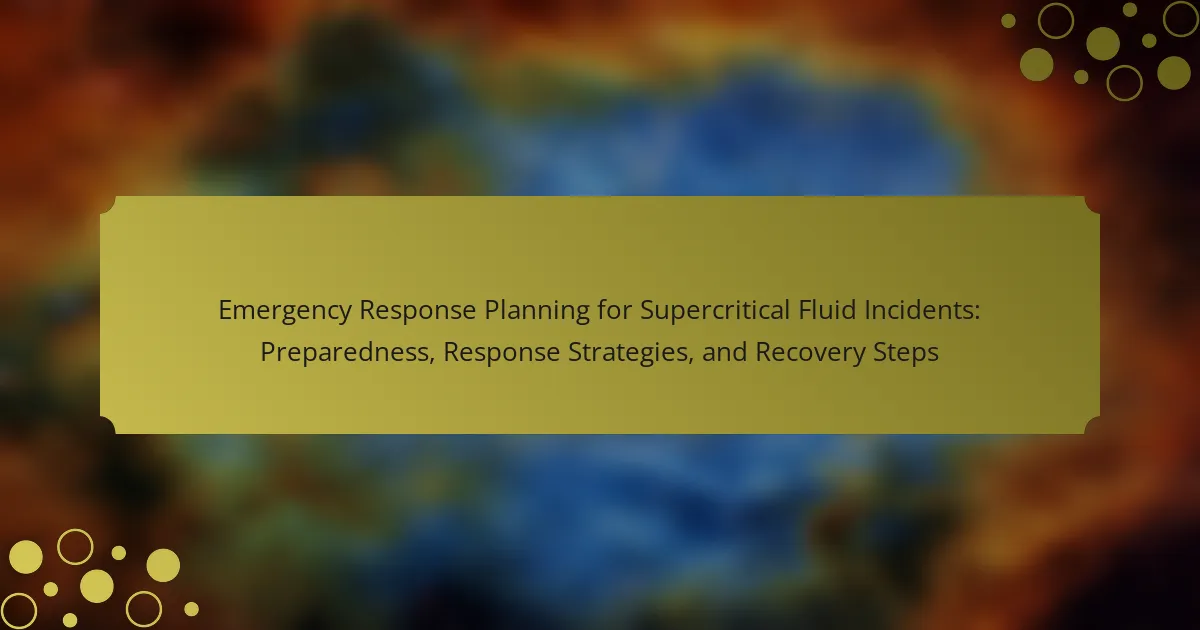Water supercritical fluids are water that has been heated and pressurized beyond its critical point, exhibiting unique properties that enhance its effectiveness as a solvent in various applications, including extraction and chemical reactions. This article outlines best practices for the safe use of water supercritical fluids, emphasizing the importance of thorough risk assessments, proper equipment maintenance, and personnel training. Key safety measures include managing high-pressure and high-temperature conditions, implementing emergency procedures, and ensuring compliance with safety regulations. By addressing potential hazards and providing guidelines for safe operations, this article aims to promote the responsible use of supercritical water in industrial settings.
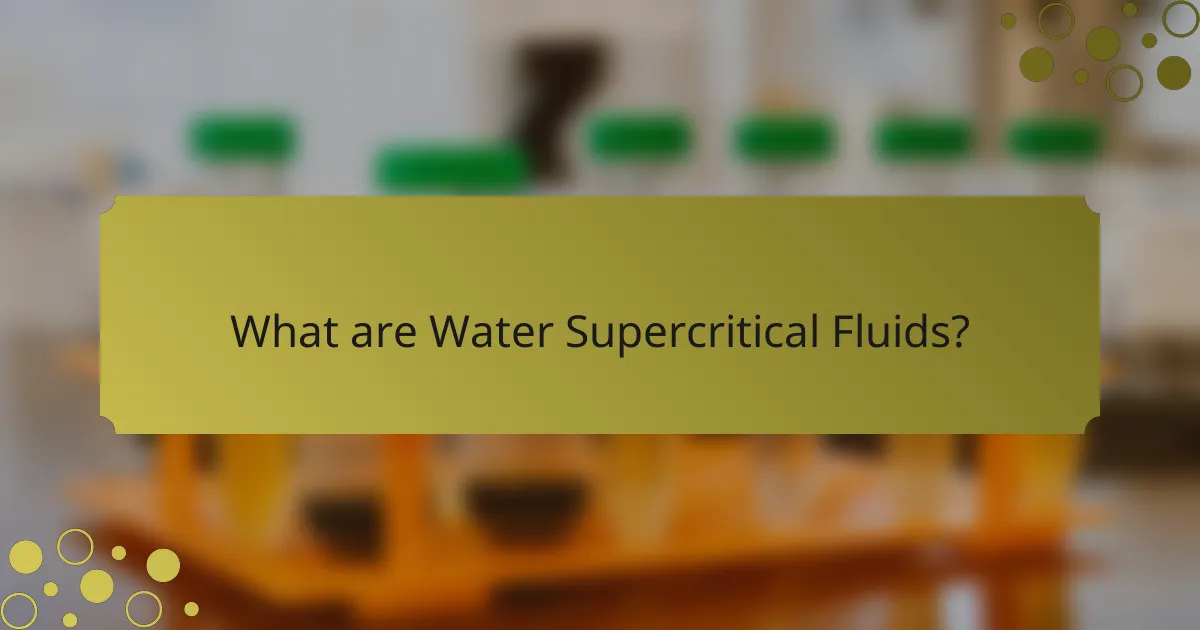
What are Water Supercritical Fluids?
Water supercritical fluids are water that has been heated and pressurized beyond its critical point. At this state, water exhibits unique properties that differ from its liquid and gas phases. Specifically, it has a density similar to that of a liquid while maintaining gas-like diffusion properties. This allows it to dissolve a wide range of substances, making it useful for various applications such as extraction and chemical reactions. The critical point for water occurs at approximately 374 degrees Celsius and 22.06 MPa (3200 psi). In this state, water can effectively act as a solvent for organic compounds, enhancing extraction efficiency. Supercritical water is also non-toxic and environmentally friendly compared to traditional solvents.
How do Water Supercritical Fluids differ from other supercritical fluids?
Water supercritical fluids differ from other supercritical fluids primarily in their unique properties and behavior. Water has a critical temperature of 374 °C and a critical pressure of 22.1 MPa. This results in water’s supercritical state having distinct solvation properties compared to carbon dioxide or other organic solvents.
In supercritical form, water exhibits a high dielectric constant, which allows it to dissolve ionic and polar compounds effectively. This contrasts with many organic supercritical fluids that primarily dissolve nonpolar substances. Additionally, water’s ability to act as both a solvent and a reactant in various chemical processes sets it apart.
Furthermore, the density of supercritical water is significantly higher than that of supercritical CO2, enhancing its effectiveness in extraction and reaction scenarios. These differences make water supercritical fluids particularly useful in applications such as biomass conversion and waste treatment, where traditional supercritical fluids may not be as effective.
What are the unique properties of water in its supercritical state?
Water in its supercritical state possesses unique properties that differentiate it from its liquid and gas forms. In this state, water exhibits both liquid-like density and gas-like viscosity. This allows it to dissolve non-polar compounds effectively. Supercritical water has a high diffusivity, enabling rapid transport of solutes. Additionally, it has a low dielectric constant, which affects its solvent capabilities. The temperature and pressure conditions for supercritical water are typically above 374°C and 22.1 MPa. These conditions alter the molecular interactions, leading to unique chemical reactivity. The unique properties of supercritical water make it useful in various applications, such as waste treatment and extraction processes.
Why is water chosen as a supercritical fluid in various applications?
Water is chosen as a supercritical fluid due to its unique properties and versatility. In its supercritical state, water exhibits enhanced solvation capabilities. This allows it to dissolve a wide range of substances, making it useful in extraction processes. Supercritical water also has low viscosity, which enables better mass transfer during reactions. Additionally, it is non-toxic and environmentally friendly, making it a safer alternative to organic solvents. Its high heat capacity allows for efficient heat transfer in various applications. Research has shown that supercritical water can effectively decompose organic waste, making it valuable in waste treatment processes. These attributes collectively contribute to water’s selection as a supercritical fluid in diverse applications.
What are the applications of Water Supercritical Fluids?
Water supercritical fluids have various applications across multiple fields. They are used in extraction processes, particularly for natural products. In the food industry, they can extract flavors and essential oils without harmful solvents. Water supercritical fluids serve as a medium for chemical reactions in green chemistry. They are also utilized in waste treatment to break down organic materials. In pharmaceuticals, they aid in drug formulation and delivery. Additionally, they are employed in material processing for producing nanomaterials. These applications highlight their versatility and environmental benefits.
In which industries are Water Supercritical Fluids most commonly used?
Water supercritical fluids are most commonly used in the food and beverage, pharmaceutical, and environmental industries. In the food industry, they are utilized for extraction processes, such as caffeine removal from coffee. The pharmaceutical sector employs water supercritical fluids for drug formulation and extraction of active compounds. Environmental applications include waste treatment and pollution remediation. These industries leverage the unique properties of water supercritical fluids for efficient and sustainable processes.
How do Water Supercritical Fluids enhance extraction processes?
Water supercritical fluids enhance extraction processes by providing a highly efficient solvent environment. In supercritical state, water exhibits unique properties that combine characteristics of both liquids and gases. This allows for better solvation of various compounds. The high diffusivity of supercritical water enables faster mass transfer during extraction. Additionally, its tunable density can be adjusted by varying temperature and pressure, optimizing extraction efficiency. Research indicates that supercritical water can extract polar and non-polar compounds effectively. Studies show that extraction yields can increase significantly compared to traditional methods. This efficiency makes water supercritical fluids a valuable tool in various industrial applications.
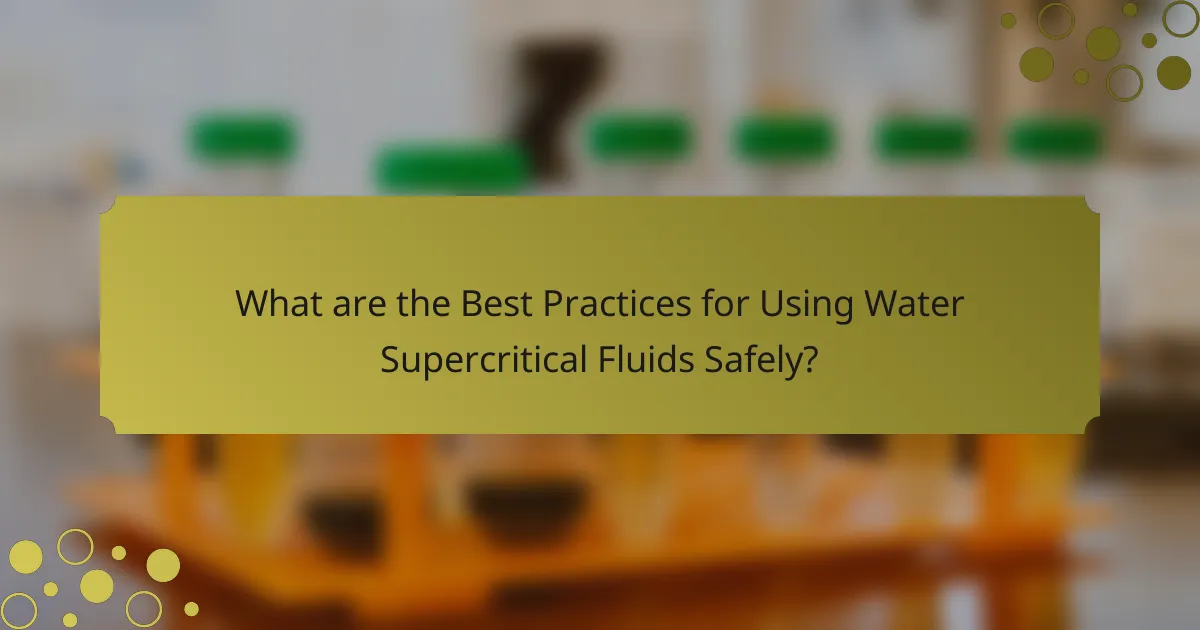
What are the Best Practices for Using Water Supercritical Fluids Safely?
Best practices for using water supercritical fluids safely include conducting thorough risk assessments. Operators should be trained in handling supercritical fluid equipment. Regular maintenance of equipment is essential to prevent leaks and failures. Proper pressure and temperature controls must be maintained to ensure safety. Safety valves should be installed to manage excess pressure. Personal protective equipment (PPE) must be worn by all personnel involved. Emergency procedures should be established and regularly practiced. Lastly, all operations should comply with relevant safety regulations and guidelines.
What equipment is necessary for the safe use of Water Supercritical Fluids?
High-pressure vessels are necessary for the safe use of water supercritical fluids. These vessels must withstand pressures exceeding 22.1 MPa. Temperature control systems are also essential to maintain optimal conditions above 374°C. Safety relief valves are critical to prevent overpressure situations. Additionally, robust piping systems are required to handle the high temperatures and pressures involved. Flow control devices ensure the proper regulation of fluid movement. Monitoring equipment is necessary for real-time observation of pressure and temperature. Finally, personal protective equipment (PPE) is vital for operators working with these systems.
How do you select the right pressure vessel for Water Supercritical Fluids?
Select a pressure vessel suitable for water supercritical fluids by evaluating material compatibility and pressure ratings. The vessel must withstand temperatures above 374°C and pressures exceeding 22.1 MPa. Stainless steel is commonly used due to its corrosion resistance and strength. Ensure the vessel design complies with industry standards, such as ASME and PED. Consider the vessel size based on the required volume of supercritical fluid. Assess safety features like pressure relief valves and monitoring systems. Review manufacturer specifications for operational limits and maintenance requirements. These criteria ensure the vessel’s safe and effective operation in supercritical fluid applications.
What safety features should be included in supercritical fluid equipment?
Supercritical fluid equipment should include pressure relief valves to prevent over-pressurization. These valves automatically release excess pressure to maintain safe operating conditions. Additionally, the equipment should have robust containment systems to manage leaks or spills. This prevents hazardous materials from escaping into the environment.
Automatic shut-off systems are critical for ensuring safety during emergencies. These systems can quickly halt operations if unsafe conditions are detected. Furthermore, temperature control mechanisms are necessary to maintain safe thermal limits. This helps avoid thermal runaway scenarios.
Regular safety interlocks must be integrated to ensure that equipment cannot operate under unsafe conditions. Training features for operators are also essential to ensure proper handling and emergency response. Lastly, safety signage and labeling should be clear and visible to enhance awareness of hazards.
What procedures should be followed for safe operations?
Safe operations with water supercritical fluids require specific procedures. Begin by conducting a thorough risk assessment before starting any operation. Ensure all equipment is properly maintained and calibrated. Operators must wear appropriate personal protective equipment (PPE) at all times. Follow established protocols for pressure and temperature monitoring during processes. Implement emergency shutdown procedures to address any unexpected incidents. Regularly train personnel on safety procedures and emergency response. Documentation of all procedures and incidents is essential for continuous improvement. These practices enhance safety and minimize risks associated with water supercritical fluid operations.
How should operators prepare for the use of Water Supercritical Fluids?
Operators should prepare for the use of Water Supercritical Fluids by conducting thorough training and risk assessments. Training should cover the properties and handling of supercritical fluids. Operators must understand the high-pressure and temperature conditions involved. They should also familiarize themselves with safety protocols and emergency procedures. Risk assessments should identify potential hazards and mitigation strategies. Equipment must be inspected and maintained regularly to ensure safety and functionality. Operators should establish clear communication channels during operations. Documentation of procedures and safety measures is essential for compliance and accountability.
What are the standard operating procedures for handling Water Supercritical Fluids?
Standard operating procedures for handling water supercritical fluids include several critical steps. First, ensure proper training for personnel on safety protocols. Second, use appropriate personal protective equipment (PPE) such as gloves and goggles. Third, maintain equipment in good working condition to prevent leaks. Fourth, monitor pressure and temperature continuously during operations. Fifth, implement emergency shutdown procedures in case of anomalies. Sixth, ensure proper ventilation in work areas to disperse any potential leaks. Seventh, conduct regular risk assessments to identify hazards. These procedures are essential for ensuring safety while working with water supercritical fluids.
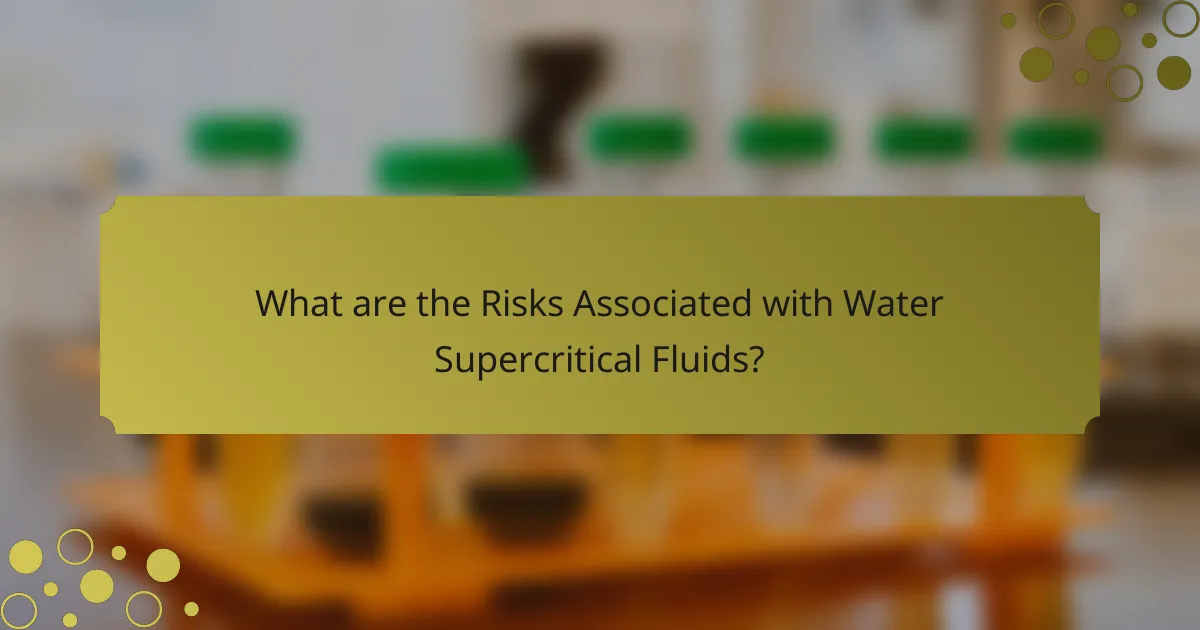
What are the Risks Associated with Water Supercritical Fluids?
Water supercritical fluids pose several risks, primarily related to pressure and temperature. These fluids operate at high pressures, typically above 22 MPa, and temperatures exceeding 374°C. Such conditions can lead to equipment failure if not properly managed.
Thermal hazards arise from the high temperatures, which can cause burns or equipment degradation. Chemical reactions may also occur, leading to the formation of hazardous by-products. Additionally, the potential for leaks exists, which can result in environmental contamination.
Proper risk assessments and safety measures are essential to mitigate these dangers. Regular maintenance and monitoring of equipment can help prevent accidents. Training personnel on safe handling procedures is also crucial for minimizing risks.
How can risks be assessed in the use of Water Supercritical Fluids?
Risks in the use of Water Supercritical Fluids can be assessed through systematic hazard identification and risk analysis. This process involves evaluating potential hazards associated with supercritical fluid properties, such as pressure and temperature. Quantitative risk assessment methods can be applied to estimate the likelihood and impact of identified risks.
Utilizing safety standards and guidelines, such as those from the American Society of Mechanical Engineers, helps in establishing safe operating conditions. Regular equipment inspections and maintenance are crucial to prevent failures. Training personnel on safety protocols enhances risk mitigation.
Additionally, case studies and historical data on supercritical fluid incidents provide insights into potential risks. This information can inform future safety measures and operational adjustments.
What factors contribute to the risk of using Water Supercritical Fluids?
Factors contributing to the risk of using Water Supercritical Fluids include high pressure and temperature conditions. These conditions can lead to equipment failure if not properly managed. Inadequate material compatibility can result in structural weaknesses. The presence of impurities in the water can cause unexpected reactions. Operator training and experience levels significantly affect safety outcomes. Failure to conduct thorough risk assessments increases potential hazards. Emergency response protocols must be established to mitigate risks. Regular maintenance of equipment is essential to ensure safe operation.
How do you conduct a risk assessment for supercritical fluid operations?
Conducting a risk assessment for supercritical fluid operations involves several systematic steps. First, identify potential hazards associated with the supercritical fluid process. This includes evaluating the physical and chemical properties of the fluid, such as pressure and temperature conditions. Next, assess the likelihood of each identified hazard occurring. Utilize historical data and incident reports to gauge frequency.
Then, evaluate the potential consequences of each hazard. Consider impacts on personnel, equipment, and the environment. Assign risk levels based on the likelihood and consequences. This can be done using a risk matrix.
After that, implement control measures to mitigate identified risks. This may involve engineering controls, administrative procedures, or personal protective equipment. Finally, document the entire risk assessment process. Ensure regular reviews and updates to the assessment as operational conditions change.
These steps align with industry standards, such as those outlined in the American Society of Mechanical Engineers (ASME) guidelines for risk management in fluid operations.
What are the common hazards related to Water Supercritical Fluids?
Common hazards related to water supercritical fluids include high pressure, high temperature, and chemical reactivity. High pressure can lead to equipment failure or leaks. High temperature poses risks of burns or thermal degradation of materials. Chemical reactivity may result in hazardous reactions with other substances. Additionally, the potential for supercritical fluid escape can create safety hazards in confined spaces. Proper risk assessments and safety protocols are essential to mitigate these hazards. Regular equipment maintenance and monitoring can help prevent incidents associated with water supercritical fluids.
What safety measures can mitigate the hazards of using Water Supercritical Fluids?
Implementing safety measures is crucial for mitigating hazards associated with Water Supercritical Fluids (WSCF). Regular equipment inspections ensure integrity and prevent leaks. Proper training for personnel minimizes human error during operations. Utilizing pressure relief valves can prevent over-pressurization incidents. Adequate ventilation in work areas reduces the risk of gas accumulation. Personal protective equipment (PPE) protects workers from exposure. Emergency response plans should be established to handle potential accidents effectively. Following these measures aligns with industry standards for safe handling of WSCF.
How can emergency situations be effectively managed during operations?
Emergency situations during operations can be effectively managed through preparation, response protocols, and training. Preparation involves conducting risk assessments to identify potential emergencies. This allows for the development of specific response plans tailored to various scenarios. Response protocols should include clear communication channels and designated roles for team members. Regular training simulations enhance team readiness and improve response times. For example, the National Fire Protection Association recommends conducting drills at least twice a year to ensure familiarity with emergency procedures. Effective management also requires regular review and updates of emergency plans based on operational changes or past incidents.
What are the best practices for troubleshooting equipment issues?
Identify the problem accurately. Gather information on the symptoms and context. Check for obvious issues such as power supply or connections. Review equipment manuals for troubleshooting guidelines. Test components systematically to isolate the issue. Document each step taken during the troubleshooting process. Consult with experts if the problem persists. Use diagnostic tools where applicable for precise analysis.
Water supercritical fluids are a unique state of water achieved through high temperature and pressure, enabling it to act as an effective solvent for various applications. This article outlines best practices for the safe use of water supercritical fluids, focusing on essential equipment, operational procedures, and comprehensive risk assessments. Key topics include the distinct properties of supercritical water, its applications across industries such as food, pharmaceuticals, and environmental management, as well as safety measures and troubleshooting methods to mitigate risks associated with high-pressure operations. The content aims to provide a structured approach to enhance safety and efficiency in utilizing water supercritical fluids.
